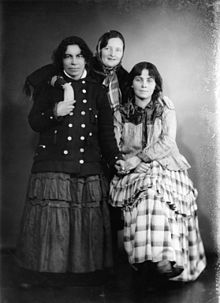
| Total population | |
|---|---|
| 17,500 | |
| Regions with significant populations | |
| 13,000 | |
| 4,500 | |
| Languages | |
| Finnish, Swedish and Finnish Romani | |
| Religion | |
| Lutheran and Pentecostal Christianity | |
| Related ethnic groups | |
| Laiuse Romani, Romanisael, Romanichal, Kale, Scottish Lowland Romani and other Romani peoples | |
The Kaale (Romani: Kàlo; Swedish: Kaale, finska romer; Finnish: Kaale, Suomen romanit; also known as Finnish Romani, Finnish Roma, Finnish Kale or Mustalainen – literally "Gypsy", often considered offensive) are a Romani subgroup who live primarily in Finland but also in Sweden. Their main languages are Finnish, Swedish and Kalo.
History

Kaale are believed to have to descended from Romanisæl who came to Finland via Sweden proper after being deported from Sweden proper in the 17th century. The ancestors of Finnish, Swedish and Norwegian Romani migrated were deported from the kingdoms of Scotland and England. In 1637, all Romani groups were declared outlaws who could be hanged without trial; this practice was discontinued in 1748. When Finland declared independence in 1917, all Kales received full citizenship and rights. During the Winter War and Continuation War, about a thousand Kales served in the Finnish military.
Culture
Dress
The traditional female Kaale dress stems from the traditional dress worn by the ethnic Finn women. Until the turn of the 20th century, Kaale and Finn women dressed much alike in blouses, long skirts, and waist aprons. Over time and with increased wealth, the female Kale dress has become continually more decorated. The dress features a heavy full-length black velvet skirt worn relatively high at the waist, supported by padding, and a puffed blouse, often with prominent ruffles and lace, made of decorative cloth such as with sequins or a metallic sheen.
Music

Music is a central part of Kaale culture, everyday entertainment and domestic life. In Finland, the Kaale are known especially for their contribution to the Finnish tango and Schlager music. Kaale men have been a vital part of the Schlager scene since the start of the genre's popularity in Finland following World War II. At first Kaale singers faced direct discrimination, and for instance were banned from performing at certain establishments either on principle or following Kaale audience misbehavior. Taisto Tammi and Markus Allan [fi] were the two most important early Kaale performers; both adopted artistic aliases to reduce attention to their ethnic background.
Perceived problems of the Kaale in Finland
Socioeconomic status
The Kaale have traditionally held positions as craftsmen, but the occupation has lost its importance in modern times, leading to a significant rise in unemployment within the group. A paper published by the Ministry of Labour states that "According to labour administration's client register material, 70% of the Roma jobseekers had a primary school or lower secondary school education." According to the same paper: "Education is compulsory in Finland and this obligation applies equally to the Roma as to other citizens, but dropping out of basic education is still common among young Roma, while in the mainstream population it is extremely uncommon."
Issues
In 2007 police officer and boxer Riku Lumberg (of Romani heritage) wrote an open letter to his own people, seeking an end to the "barbaric tradition of blood feud" in the community. Romani artist Kiba Lumberg has said the following about the culture she grew up in: "Blood feud and the violence that exists in Roma culture can't be discussed in Finland. We can't accept that some groups hide behind culture to excuse stepping on human rights and freedom of speech," and "the problem is, that when a Gypsy dares to speak in public about the negative things happening in their own tribe, they face death threats. If a white person opens their mouth, they're accused of racism."
Finnish Romani in Sweden
From the 1950s, Finnish Romani have moved to Sweden, mainly due to better job opportunities and less discrimination. Around 4,500 Finnish Romani live in Sweden. They are the only Romani group in Sweden who wear their traditional dress. In Sweden it is easier for Finnish Romani to get a job and an apartment due to more Swedish sounding surnames as well as a long tradition of multiculturalism in Sweden.
Notable people of Kaale descent

- Remu Aaltonen, drummer and singer
- Veijo Baltzar, author and director
- Jasmine, singer
- Kiba Lumberg, author, artist and critic of violence in Roma culture
- Amadeus Lundberg, singer, Tango King
- Miranda Vuolasranta, activist and educator
See also
- Kale
- Romanichal
- Romanisæl
- Scottish Lowland Romani
- Laiuse Romani language
- Irish Travellers
- Romani diaspora
- Romani people in Finland
References
- "Julkaisut". Sosiaali- ja terveysministeriö.
- "Suomen romanit ovat yli 4 000 ihmisen tuplavähemmistö Ruotsissa: "Suomi on meidänkin maamme"". www.iltalehti.fi. Retrieved 12 December 2023.
- "Factsheet. Kaale in Finland". rm.coe.int. Retrieved 12 December 2023.
- "Romani, Kalo Finnish". Retrieved 12 December 2023.
- Eltzler. Zigenarna och deras avkomlingar i Sverige (Uppsala 1944) cited in: Angus. M. Fraser. The Gypsies (The Peoples of Europe) p120
- "Finnish Romani" (PDF). spraakdata.gu.se.
- "Mansetori.fi". mansetori.fi.
- "Tie romanien elämään" (in Finnish). Suomen käsityön museo. Archived from the original on 5 March 2016. Retrieved 2 March 2013.
- "Music of the Finnish Romani: roaming and singing". FMQ. 21 August 2017. Retrieved 12 December 2023.
- "Romanit Suomessa Suomen Romanifoorumi". Archived from the original on 20 July 2011. Retrieved 22 March 2010.
- "Heikko koulutus pitää romanit poissa työelämästä" [Low level of education keeps Romani out of employment]. Keskisuomalainen (in Finnish). 11 September 2008. Archived from the original on 16 July 2011. Retrieved 29 May 2010.
- Lumberg, Riku (19 August 2007). "Riku Lumbergin avoin kirje romaniyhteisölle" [Riku Lumberg's open letter to the Romani community]. Helsingin Sanomat (in Finnish). Helsinki. Retrieved 1 November 2009.
- Varpula, Sari (16 August 2007). "Taiteilija Kiba Lumberg: Sieluni ei mahdu mustalaishameeseen". Sana (in Finnish). Helsinki. Archived from the original on 23 March 2008. Retrieved 1 November 2009.
- "2. Romer i Sverige".
- "Tuhannet Suomen romanit löysivät pysyvän kodin Ruotsista – monien mielestä elämä on parempaa Pohjanlahden takana".
- Rantala, Risto, ed. (1998). Kuka kukin on: Henkilötietoja nykypolven suomalaisista 1998 (in Finnish). Helsinki: Otava. p. 18. ISBN 951-1-14344-1.
Sources
- Finland's Romani People — Finitiko romaseele
- Paper on the unemployment of Finnish Kale by the Ministry of Labour (English summary included)
| Immigration to Finland | ||
|---|---|---|
| Europe |  | |
| Middle East | ||
| South & East Asia | ||
| Africa | ||
| Americas | ||
| Persons | ||
| See also | ||
| Subgroups and diaspora of Finnish people | |||||||
|---|---|---|---|---|---|---|---|
| Traditional subgroups or tribes (heimot) | |||||||
| Diaspora |
| ||||||
| Persons |
| ||||||